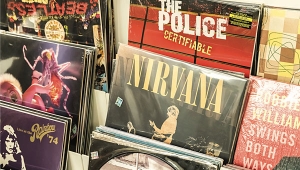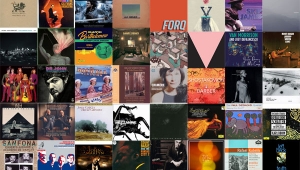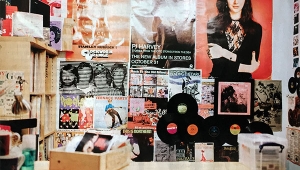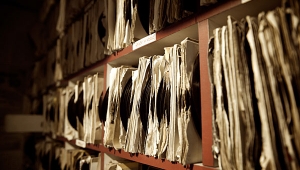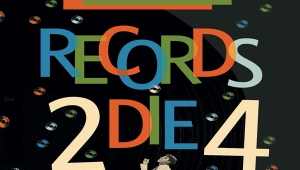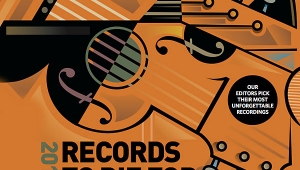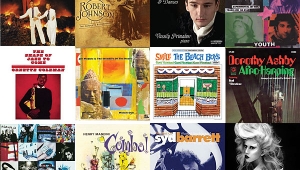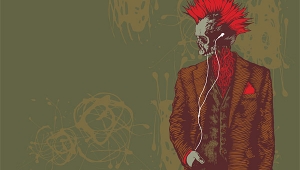| Columns Retired Columns & Blogs |
1991 Records To Die For Page 5
Mortimer H. Frank
BACH: Cantata BWV 79, "Gott der Herr, ist Sonn und Schild"
(with Cantatas BWV 76-78)
Paul Esswood, countertenor; Max van Egmond, bass; Gustav Leonhardt
Teldec 35362 EX (2 CDs only). ADD. TT: 16:32
Composed to celebrate the Protestant Reformation, this cantata stands as one of the peaks of the Bach canon. Its opening chorus is grandly festive and features virtuosic writing for horns and a richly textured fugue. Its chorales, with their accompanying timpani and horns, echo this spirit and serve as apt foils for two gorgeous arias. Directing period instruments, Leonhardt produces a reading that is colorful, transparent, joyous, and musical without any of the affectations that afflict some of the other performances in this Teldec series. And the recording captures the intimacy of the small ensemble without mitigating the music's jubilant extraversion. Among Bach-cantata recordings, this is a model of its kind.
BARTÓK: Concerto for Orchestra; Music for Strings, Percussion and Celeste
Fritz Reiner, Chicago Symphony
RCA 5604-2 RC (CD only). Lewis Layton, eng.; Richard Mohr, prod. ADD. TT: 65:05
Although Koussevitsky led the premiere of the Concerto, Reiner made the first recording of the score (with the Pittsburgh Symphony). This remake is a phonographic classic: lean, vibrant, and---in the early-stereo engineering---wonderfully musical in its clarification of pointed antiphonal effects. MSPC is, if anything, even better. The slightly acidic string tone Reiner favored suits the work perfectly, and he projects its crackling energy and eerie gloom with a controlled intensity that remains all too uncommon. Despite some tape hiss (more noticeable in the Concerto), the sound retains a natural ambience and impact remarkable for 30-year-old recordings.
BEETHOVEN: String Quartet 10, Op.74
(with String Quartet 9, Op.59 No.3)
Smetana Quartet
Denon C37-7125 (CD only). VÁclav Roubal, eng.; Eduard Herzog, prod. DDD. TT: 62:05
The elegance, aristocratic poise, impeccable balance, and tonal opulence that stamp this performance make it unique among the recordings of this undervalued masterpiece. Especially compelling are the unsentimentalized lyricism of the slow movement, the attention to harmonic motion that defines the structure of the finale, and the almost breathtaking virtuosity in the coda of the first movement---one of the miraculous passages in Beethoven where an orgiastic joy is made all the more communicative by the composer's---and the Smetana's---firm artistic control. Denon's close engineering is free of harshness, and if the performers' breathing were not occasionally audible, this recording might well have achieved the impossible-to-attain sonic ideal.
MOZART: Symphony 41
(with Symphony 40)
George Szell, Cleveland Orchestra
CBS MS-6969 (LP). Paul Myers, prod. AAA. TT: 70:33
Perfection may never be reached, but this performance of Mozart's "Jupiter" Symphony comes very, very close. Szell's tempos are judicious, his sense of style is flawless, and the vibrant vigor he brings to the finale in no way compromises the clarity of its rich contrapuntal writing, the coda, in particular, being revealed in all its polyphonic complexity with a resulting clarification of structure that I have never encountered in any other recording. As heard in its original LP release, the sound was close, a trifle bright and astringent, yet absolutely right for the music, suggesting (without duplicating) the sonority of period instruments. Unfortunately, subsequent reissues have falsified the original engineering, the CD (CBS MK 42418) having an added resonance that veils the clarity Szell and his extraordinary orchestra produced. If you find a clean copy of the original LP release, grab it.
SCHUMANN: The Four Symphonies
Herbert von Karajan, Berlin Philharmonic
DG 429 672-2 (2 CDs only). Günter Hermanns, eng.; Hans Weber, prod. ADD. TT: 2:13:14
Anyone who doubts Karajan's greatness should hear these performances. Without resorting to retouchings, the conductor (unlike such eminences as Toscanini, Bernstein, and Szell) makes a compelling case for Schumann's original orchestrations, and his grasp of the music's spirit goes right to the core of each work. Among the highlights of these readings are the gemütlich grace in the outer movements of 1, the singing legato line of the slow movement of 2, the noble grandeur of 3, and a firmly disciplined rhythmic flexibility throughout 4, where the Florestan/Eusebius duality of Schumann's writing is especially well-clarified. DG's sound is rich and natural, with great impact at climaxes.

Gary A. Galo
DVORÁK: Symphony 9, "From the New World"
WAGNER: Overture to The Flying Dutchman, Siegfried-Idyll
Jascha Horenstein, Royal Philharmonic Orchestra
Chesky CD-31 (CD only). Kenneth E. Wilkinson, eng.; Charles Gerhardt, prod. ADD. TT: 67:30
Horenstein's "New World" is one of the finest in stereo, holding its own with Kubelik and Kertész. His is a flexible yet unmannered performance, with tremendous intensity in the outer movements and a beautiful lyricism in the Largo. The Royal Philharmonic's playing is first-rate. The superb analog original has been well-served by this 20-bit, 128x-oversampled transfer, and the textures of the massed strings are amazingly realistic. The recording has excellent clarity complemented by a warm acoustic. (XIII-4)
MAHLER: Symphony 5
Eliahu Inbal, Frankfurt Radio Symphony Orchestra
Denon 33CO-1088 (CD only). Peter Willemoës, Detlev Kittler, engs.; Yoshiharu Kawaguchi, Richard Hauck, prods. DDD. TT: 72:22
Denon's complete Mahler cycle established Eliahu Inbal as one of the foremost Mahler interpreters of the past 30 years. Inbal makes structural sense out of these difficult works, a refreshing contrast to Bernstein's "climax every five minutes" approach. The two-spaced-omni recording does not have the pinpoint localization and detail heard on London's Respighi disc, the perspective being mid-hall, orchestra section rather than balcony. But the sound is spacious and natural, with excellent accuracy of individual instrumental timbres. Probably the best recorded Mahler Fifth. (X-8)
RESPIGHI: The Pines of Rome, Roman Festivals, The Fountains of Rome
Charles Dutoit, Montreal Symphony Orchestra
London 410 145-2 (CD only). John Dunkerley, eng.; Ray Minshull, prod. DDD. TT: 60:24
Of all the stereo recordings, Dutoit's come the closest to Toscanini's rhythmic vitality and delineation of orchestral color and detail. The Montreal Symphony's playing is world-class, captured in a reference-quality recording. The tremendous high-frequency energy of Respighi's orchestrations, realistically recorded, will tax many CD players and systems. The soundstage is large and three-dimensional, with pinpoint localization of instruments and incredible inner detail complemented by natural hall ambience. The organ pedal in Pines of the Appian Way will rattle your floors.
VERDI: Aïda
Renata Tebaldi, A;d;ida; Carlo Bergonzi, Rhadames; Giulietta Simionato, Amneris; Cornell Macneil, Amonasro; Arnold van Mill, Ramphis; others. Vienna Philharmonic Orchestra, Herbert von Karajan
London 414 087-2 (3 CDs only). James Brown, eng.; John Culshaw, prod. ADD. TT: 2:30:08
Herbert von Karajan's Grand Opera approach to this score is notable for its incredible sweep and forward momentum. Renata Tebaldi is captured in one of her best roles, and Carlo Bergonzi sings Rhadames with a velvety tone and impeccable legato that eludes any of today's tenors. Giulietta Simionato is, vocally and dramatically, simply the finest Amneris on record. The recording is opulent and spacious, with realistic depth, flattering Karajan's approach to the score. The massed choral passages are particularly impressive. Tape hiss is barely noticeable.
WAGNER: Der Ring des Nibelungen
Birgit Nilsson, Hans Hotter, Wolfgang Windgassen, George London, Regine Crespin, James King, Gottlob Frick, Kirsten Flagstad, Dietrich Fischer-Dieskau, Gerhard Stolze; many others; Vienna State Opera Chorus, Vienna Philharmonic Orchestra, Sir Georg Solti
London 414 100-2 (15 CDs only). Gordon Parry, eng.; John Culshaw, prod. ADD. TT: 14:37:42
Also available individually: Das Rheingold, 414 101-2; Die Walküre, 414 105-2; Siegfried, 414 110-2; Götterdämmerung, 414 115-2.
Twenty-five years after its completion, Decca/London's Ring remains one of recorded music's greatest achievements. The last of the great Wagner singers were captured in their prime, and Solti's high-energy approach is complemented by impeccable playing from the Vienna Philharmonic. Overall, no stereo performance comes even close. The recordings remain sonically stunning, particularly Donner's hammerblow and thunderclap in Das Rheingold, the Forging Scene in Act I of Siegfried, and Siegfried's Funeral Music and the Immolation Scene in Act III of Götterdämmerung. Transfers from original master tapes result in less tape hiss than my German LPs. Extreme low bass is a bit thin by today's standards, but the full power and weight of a symphony orchestra is still delivered with tremendous impact. A single CD excerpts disc (421 313-2) appears to be from analog copies of the originals and is not recommended.

Larry Greenhill
BILLY JOEL: Songs in the Attic
Columbia TC 37461 (LP only recommended). Phil Ramone, Brian Rugges, prods. DAA. TT: 47:58
This LP has become my favorite live concert recording. Joel's chemistry with his band and audience come across with remarkable ferocity. Ramone and Joel set up the 15-city concert tour to capture the performer's stage presence. Eleven ambience-charged songs taken from eight different performances give different sonic effects.
THE L.A. FOUR: Going Home
Laurindo Almeida, guitar; Ray Brown, bass; Shelley Mann, drums
East Wind 32JD-10043 (CD only). AAD. TT: 32:30
This is my favorite jazz CD. I can't recommend it too highly. The title cut combines superb imaging, highly localized instruments, terrific instrumental timbres, and a minimum of reverberation. The flute and guitar, placed contrapuntally at opposite ends of the soundstage, deliver wonderful solos. The other cuts, "Django," "Recipe of Love," "Greensleeves," "Softly as in a Morning Sunrise," and "Romance de Amor" are polished, dynamic, and prove what fine musicians each of the performers are. This CD has less edginess, harshness, and abrasiveness than most of my vinyl recordings, and can be played time and again without listener fatique.
WILLIE NELSON: Always on My Mind
CBS CK 37951. Chips Moman, prod.; Chips Moman, David Cherry, Larry Greenhill, engs. AAD.
Since 1983, I've adopted this CD as a special test of small-group dynamics, vocal tonal quality, vocal resonance, and midrange naturalness. (Of course, the fact that one of the recording engineers has my name did not influence my choice at all!) Nelson's voice has to appear focused between the speakers, dense, raspy, three-dimensional, and not diffuse. Listen to "Bridge Over Troubled Waters"---the close miking, tight, focused backup, and slow buildup make it my favorite version of the Simon & Garfunkel classic. Unlike many other one-song albums, this one's full of vintage Willie at his very, very best: "Last Thing I Needed First Thing This Morning," "Do Right Woman, Do Right Man," "Always on My Mind," "Permanently Lonely," "Staring Each Other Down." In short, this is a great performer on one of the only 1982-84 CDs with decent sonics; it still sounds great today.
WAGNER: Selections
Ride of the Valkyries; Tristan Prelude, Act I; Siegfried's Funeral Music; Forest Murmurs
Erich Leinsdorf, Los Angeles Philharmonic
Sheffield Lab 7 (LP only recommended). Lincoln Mayorga, Doug Sax, prods. A-A. TT: 35:50
This album represents my favorite orchestral piece recorded by Sheffield, and was one of their first direct-to-disc, "unedited" orchestral recordings. I prefer the limited-edition, now-unavailable direct-to-disc LP to the current CD release. Leinsdorf gives a very emotional, operatic, and stormy reading---which I think is appropriate---without being overblown. The string tone captured here has a full-bodied quality, with great resonance. The bite of the trombones and brass is unusually vibrant, and I have never heard the resonance of the celli reproduced better. On the best systems, the flute seems to float above the orchestra. "Siegfried's Funeral Music" is rendered with an astonishing dynamic range. Such unusual dynamics preceded the digital era, and constitute much more "natural" dynamic peak than cannon shots or bass drums falling on stages. Wagner's variegated tonal color plus the sonic transparency, the utter naturalness of the instruments, and the phenomenal dynamic range, combine to make this record unique.
THE WEAVERS: Reunion at Carnegie Hall
Vanguard VSD 2150 (LP only recommended). AAA. TT: 33:55
It's hard to believe that the Weavers had been famous for 15 years when they reunited to sing at Carnegie Hall in 1963. The performances are first-rate. Pete Seeger was at the top of his form; his tenor voice has never sounded clearer. It's here on this record. Ronnie Gilbert's soprano voice has a warmth and color that adds fire to my favorite cut, "Guantanamera."
BACH: Cantata BWV 79, "Gott der Herr, ist Sonn und Schild"
(with Cantatas BWV 76-78)
Paul Esswood, countertenor; Max van Egmond, bass; Gustav Leonhardt
Teldec 35362 EX (2 CDs only). ADD. TT: 16:32
Composed to celebrate the Protestant Reformation, this cantata stands as one of the peaks of the Bach canon. Its opening chorus is grandly festive and features virtuosic writing for horns and a richly textured fugue. Its chorales, with their accompanying timpani and horns, echo this spirit and serve as apt foils for two gorgeous arias. Directing period instruments, Leonhardt produces a reading that is colorful, transparent, joyous, and musical without any of the affectations that afflict some of the other performances in this Teldec series. And the recording captures the intimacy of the small ensemble without mitigating the music's jubilant extraversion. Among Bach-cantata recordings, this is a model of its kind.
BARTÓK: Concerto for Orchestra; Music for Strings, Percussion and Celeste
Fritz Reiner, Chicago Symphony
RCA 5604-2 RC (CD only). Lewis Layton, eng.; Richard Mohr, prod. ADD. TT: 65:05
Although Koussevitsky led the premiere of the Concerto, Reiner made the first recording of the score (with the Pittsburgh Symphony). This remake is a phonographic classic: lean, vibrant, and---in the early-stereo engineering---wonderfully musical in its clarification of pointed antiphonal effects. MSPC is, if anything, even better. The slightly acidic string tone Reiner favored suits the work perfectly, and he projects its crackling energy and eerie gloom with a controlled intensity that remains all too uncommon. Despite some tape hiss (more noticeable in the Concerto), the sound retains a natural ambience and impact remarkable for 30-year-old recordings.
BEETHOVEN: String Quartet 10, Op.74
(with String Quartet 9, Op.59 No.3)
Smetana Quartet
Denon C37-7125 (CD only). VÁclav Roubal, eng.; Eduard Herzog, prod. DDD. TT: 62:05
The elegance, aristocratic poise, impeccable balance, and tonal opulence that stamp this performance make it unique among the recordings of this undervalued masterpiece. Especially compelling are the unsentimentalized lyricism of the slow movement, the attention to harmonic motion that defines the structure of the finale, and the almost breathtaking virtuosity in the coda of the first movement---one of the miraculous passages in Beethoven where an orgiastic joy is made all the more communicative by the composer's---and the Smetana's---firm artistic control. Denon's close engineering is free of harshness, and if the performers' breathing were not occasionally audible, this recording might well have achieved the impossible-to-attain sonic ideal.
MOZART: Symphony 41
(with Symphony 40)
George Szell, Cleveland Orchestra
CBS MS-6969 (LP). Paul Myers, prod. AAA. TT: 70:33
Perfection may never be reached, but this performance of Mozart's "Jupiter" Symphony comes very, very close. Szell's tempos are judicious, his sense of style is flawless, and the vibrant vigor he brings to the finale in no way compromises the clarity of its rich contrapuntal writing, the coda, in particular, being revealed in all its polyphonic complexity with a resulting clarification of structure that I have never encountered in any other recording. As heard in its original LP release, the sound was close, a trifle bright and astringent, yet absolutely right for the music, suggesting (without duplicating) the sonority of period instruments. Unfortunately, subsequent reissues have falsified the original engineering, the CD (CBS MK 42418) having an added resonance that veils the clarity Szell and his extraordinary orchestra produced. If you find a clean copy of the original LP release, grab it.
SCHUMANN: The Four Symphonies
Herbert von Karajan, Berlin Philharmonic
DG 429 672-2 (2 CDs only). Günter Hermanns, eng.; Hans Weber, prod. ADD. TT: 2:13:14
Anyone who doubts Karajan's greatness should hear these performances. Without resorting to retouchings, the conductor (unlike such eminences as Toscanini, Bernstein, and Szell) makes a compelling case for Schumann's original orchestrations, and his grasp of the music's spirit goes right to the core of each work. Among the highlights of these readings are the gemütlich grace in the outer movements of 1, the singing legato line of the slow movement of 2, the noble grandeur of 3, and a firmly disciplined rhythmic flexibility throughout 4, where the Florestan/Eusebius duality of Schumann's writing is especially well-clarified. DG's sound is rich and natural, with great impact at climaxes.
Gary A. Galo
DVORÁK: Symphony 9, "From the New World"
WAGNER: Overture to The Flying Dutchman, Siegfried-Idyll
Jascha Horenstein, Royal Philharmonic Orchestra
Chesky CD-31 (CD only). Kenneth E. Wilkinson, eng.; Charles Gerhardt, prod. ADD. TT: 67:30
Horenstein's "New World" is one of the finest in stereo, holding its own with Kubelik and Kertész. His is a flexible yet unmannered performance, with tremendous intensity in the outer movements and a beautiful lyricism in the Largo. The Royal Philharmonic's playing is first-rate. The superb analog original has been well-served by this 20-bit, 128x-oversampled transfer, and the textures of the massed strings are amazingly realistic. The recording has excellent clarity complemented by a warm acoustic. (XIII-4)
MAHLER: Symphony 5
Eliahu Inbal, Frankfurt Radio Symphony Orchestra
Denon 33CO-1088 (CD only). Peter Willemoës, Detlev Kittler, engs.; Yoshiharu Kawaguchi, Richard Hauck, prods. DDD. TT: 72:22
Denon's complete Mahler cycle established Eliahu Inbal as one of the foremost Mahler interpreters of the past 30 years. Inbal makes structural sense out of these difficult works, a refreshing contrast to Bernstein's "climax every five minutes" approach. The two-spaced-omni recording does not have the pinpoint localization and detail heard on London's Respighi disc, the perspective being mid-hall, orchestra section rather than balcony. But the sound is spacious and natural, with excellent accuracy of individual instrumental timbres. Probably the best recorded Mahler Fifth. (X-8)
RESPIGHI: The Pines of Rome, Roman Festivals, The Fountains of Rome
Charles Dutoit, Montreal Symphony Orchestra
London 410 145-2 (CD only). John Dunkerley, eng.; Ray Minshull, prod. DDD. TT: 60:24
Of all the stereo recordings, Dutoit's come the closest to Toscanini's rhythmic vitality and delineation of orchestral color and detail. The Montreal Symphony's playing is world-class, captured in a reference-quality recording. The tremendous high-frequency energy of Respighi's orchestrations, realistically recorded, will tax many CD players and systems. The soundstage is large and three-dimensional, with pinpoint localization of instruments and incredible inner detail complemented by natural hall ambience. The organ pedal in Pines of the Appian Way will rattle your floors.
VERDI: Aïda
Renata Tebaldi, A;d;ida; Carlo Bergonzi, Rhadames; Giulietta Simionato, Amneris; Cornell Macneil, Amonasro; Arnold van Mill, Ramphis; others. Vienna Philharmonic Orchestra, Herbert von Karajan
London 414 087-2 (3 CDs only). James Brown, eng.; John Culshaw, prod. ADD. TT: 2:30:08
Herbert von Karajan's Grand Opera approach to this score is notable for its incredible sweep and forward momentum. Renata Tebaldi is captured in one of her best roles, and Carlo Bergonzi sings Rhadames with a velvety tone and impeccable legato that eludes any of today's tenors. Giulietta Simionato is, vocally and dramatically, simply the finest Amneris on record. The recording is opulent and spacious, with realistic depth, flattering Karajan's approach to the score. The massed choral passages are particularly impressive. Tape hiss is barely noticeable.
WAGNER: Der Ring des Nibelungen
Birgit Nilsson, Hans Hotter, Wolfgang Windgassen, George London, Regine Crespin, James King, Gottlob Frick, Kirsten Flagstad, Dietrich Fischer-Dieskau, Gerhard Stolze; many others; Vienna State Opera Chorus, Vienna Philharmonic Orchestra, Sir Georg Solti
London 414 100-2 (15 CDs only). Gordon Parry, eng.; John Culshaw, prod. ADD. TT: 14:37:42
Also available individually: Das Rheingold, 414 101-2; Die Walküre, 414 105-2; Siegfried, 414 110-2; Götterdämmerung, 414 115-2.
Twenty-five years after its completion, Decca/London's Ring remains one of recorded music's greatest achievements. The last of the great Wagner singers were captured in their prime, and Solti's high-energy approach is complemented by impeccable playing from the Vienna Philharmonic. Overall, no stereo performance comes even close. The recordings remain sonically stunning, particularly Donner's hammerblow and thunderclap in Das Rheingold, the Forging Scene in Act I of Siegfried, and Siegfried's Funeral Music and the Immolation Scene in Act III of Götterdämmerung. Transfers from original master tapes result in less tape hiss than my German LPs. Extreme low bass is a bit thin by today's standards, but the full power and weight of a symphony orchestra is still delivered with tremendous impact. A single CD excerpts disc (421 313-2) appears to be from analog copies of the originals and is not recommended.
Larry Greenhill
BILLY JOEL: Songs in the Attic
Columbia TC 37461 (LP only recommended). Phil Ramone, Brian Rugges, prods. DAA. TT: 47:58
This LP has become my favorite live concert recording. Joel's chemistry with his band and audience come across with remarkable ferocity. Ramone and Joel set up the 15-city concert tour to capture the performer's stage presence. Eleven ambience-charged songs taken from eight different performances give different sonic effects.
Take the big, splashy, Liza Minelli-style production of "Miami 2017 (Seen the lights go out on Broadway)." Joel mixes apocalyptic, nuclear-holocaust cynicism with Big Apple geography. He pumps the audience, then the band, and the resulting emotional escalation and big soundstage really make it happen. Madison Square Garden's grandeur and cavernous depth make "Miami 2017" bigger than life. On "Captain Jack," a disturbing and eerie song about drug involvement, he slides the other way, dissolving in slurred phrases, references to masturbation, and a finish in death.
THE L.A. FOUR: Going Home
Laurindo Almeida, guitar; Ray Brown, bass; Shelley Mann, drums
East Wind 32JD-10043 (CD only). AAD. TT: 32:30
This is my favorite jazz CD. I can't recommend it too highly. The title cut combines superb imaging, highly localized instruments, terrific instrumental timbres, and a minimum of reverberation. The flute and guitar, placed contrapuntally at opposite ends of the soundstage, deliver wonderful solos. The other cuts, "Django," "Recipe of Love," "Greensleeves," "Softly as in a Morning Sunrise," and "Romance de Amor" are polished, dynamic, and prove what fine musicians each of the performers are. This CD has less edginess, harshness, and abrasiveness than most of my vinyl recordings, and can be played time and again without listener fatique.
WILLIE NELSON: Always on My Mind
CBS CK 37951. Chips Moman, prod.; Chips Moman, David Cherry, Larry Greenhill, engs. AAD.
Since 1983, I've adopted this CD as a special test of small-group dynamics, vocal tonal quality, vocal resonance, and midrange naturalness. (Of course, the fact that one of the recording engineers has my name did not influence my choice at all!) Nelson's voice has to appear focused between the speakers, dense, raspy, three-dimensional, and not diffuse. Listen to "Bridge Over Troubled Waters"---the close miking, tight, focused backup, and slow buildup make it my favorite version of the Simon & Garfunkel classic. Unlike many other one-song albums, this one's full of vintage Willie at his very, very best: "Last Thing I Needed First Thing This Morning," "Do Right Woman, Do Right Man," "Always on My Mind," "Permanently Lonely," "Staring Each Other Down." In short, this is a great performer on one of the only 1982-84 CDs with decent sonics; it still sounds great today.
WAGNER: Selections
Ride of the Valkyries; Tristan Prelude, Act I; Siegfried's Funeral Music; Forest Murmurs
Erich Leinsdorf, Los Angeles Philharmonic
Sheffield Lab 7 (LP only recommended). Lincoln Mayorga, Doug Sax, prods. A-A. TT: 35:50
This album represents my favorite orchestral piece recorded by Sheffield, and was one of their first direct-to-disc, "unedited" orchestral recordings. I prefer the limited-edition, now-unavailable direct-to-disc LP to the current CD release. Leinsdorf gives a very emotional, operatic, and stormy reading---which I think is appropriate---without being overblown. The string tone captured here has a full-bodied quality, with great resonance. The bite of the trombones and brass is unusually vibrant, and I have never heard the resonance of the celli reproduced better. On the best systems, the flute seems to float above the orchestra. "Siegfried's Funeral Music" is rendered with an astonishing dynamic range. Such unusual dynamics preceded the digital era, and constitute much more "natural" dynamic peak than cannon shots or bass drums falling on stages. Wagner's variegated tonal color plus the sonic transparency, the utter naturalness of the instruments, and the phenomenal dynamic range, combine to make this record unique.
THE WEAVERS: Reunion at Carnegie Hall
Vanguard VSD 2150 (LP only recommended). AAA. TT: 33:55
It's hard to believe that the Weavers had been famous for 15 years when they reunited to sing at Carnegie Hall in 1963. The performances are first-rate. Pete Seeger was at the top of his form; his tenor voice has never sounded clearer. It's here on this record. Ronnie Gilbert's soprano voice has a warmth and color that adds fire to my favorite cut, "Guantanamera."
"Guantanamera" is my acid test for reviewing. It's all there---natural vocal resonances; imaging, both in terms of soundstage width and soundstage depth; deep but subtle bass in the form of Bernie Krause tapping his foot; Ronnie Gilbert's tragic, chilling soprano; and the hall ambience. With outstanding components---and total quiet in my listening room---this record produces the most natural approximation of live music I know of. This naturalness becomes a benchmark for what I love in audio.
- Log in or register to post comments



